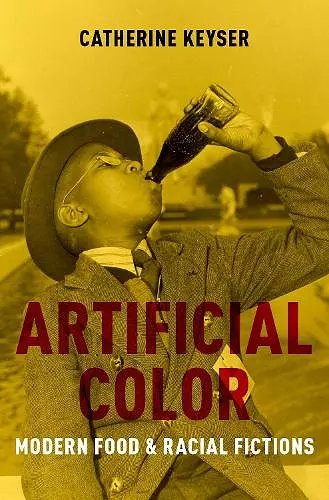Artificial Color
Modern Food and Racial Fictions
Format:Hardback
Publisher:Oxford University Press Inc
Published:21st Feb '19
Currently unavailable, and unfortunately no date known when it will be back
This hardback is available in another edition too:
- Paperback£21.49(9780197620182)

In Artificial Color, Catherine Keyser examines the early twentieth century phenomenon, wherein US writers became fascinated with modern food--global geographies, nutritional theories, and technological innovations. African American literature of the 1920s and 1930s uses new food technologies as imaginative models for resisting and recasting oppressive racial categories. In his masterwork Cane (1923), Jean Toomer follows sugar from the boiling-pots of the South to the speakeasies of the North. Through effervescent and colorful soda, he rejects the binary of black and white in favor of a dream of artificial color and a new American race. In his serial science fiction, Black Empire (1938-39), George Schuyler associates hydroponics and raw foods with racial hybridity and utopian futures. The second half of the book focuses on white expatriate writers who experienced local food cultures as sensuous encounters with racial others. Ernest Hemingway and Gertrude Stein associate regional European races with the ideal of terroir and aspire to transplantation through their own connoisseurship. In their novels set in the Mediterranean, F. Scott and Zelda Fitzgerald both dramatize the white body's susceptibility to intoxicating and stimulating substances like wine and coffee. For Scott Fitzgerald, the climatological and culinary corruption of the South produces the tragic fall of white masculinity. For Zelda, by contrast, it exposes the destructiveness and fictitiousness of the white feminine purity ideal. During the Great Depression and the Second World War, African American writers Zora Neale Hurston and Dorothy West exposed the racism that shaped the global food industry and the precarity of black labor. Their engagement with food, however, insisted upon pleasure as well as vulnerability, the potential of sensuous flesh and racial affiliation. In its embrace of invention and interconnection, Catherine Keyser contends, this modern fiction reveals that, far from being stable, whiteness may be the most obviously artificial color of them all.
In Artificial Color, Catherine Keyser makes visible how race is constructed in American literature in the first half of the twentieth century through references to and depictions of food. Keyser's reading of well- and lesser known-as well as unpublished-texts is precise, engaging, and ultimately very satisfying. * Katharina Vester, Associate professor at American University in Washington, D.C., Technology and Culture *
This sophisticated, incisive book explores literature's capacity to imagine what might be, while detailing the intertwined histories of food and race that determined what was -- and is. In our moment of flourishing "foodie" culture, resurgent white nationalism, and expansive Black protest, Artificial Color is a timely and important book. * Judges comments for the Modernist Studies Association 2019 Book Prize *
In Artificial Color everything is interconnected. The ecosystems which produce food and the commercial systems which distribute it are political. The politics of race, class, and culture are inextricably connected to the systems in which they operate. ... Throughout Artificial Color, Keyser maintains our focus on each of these interconnected but complex strands of thought: cultural production and food production are never too far apart. * Modernism/modernity *
In Artificial Color, Catherine Keyser has produced a book that will quickly become a pivotal text in critical eating studies. It makes clear how an understanding of the alimentary intimacies in writings by Fitzgerald, Toomer, Schuyler, Stein, Hurston, West, and Hemingway oblige us to think about food's racial embodiment. With its elegant readings of modern US narrative literature on both sides of the color line, Keyser asks us to think about how food can be an imaginative vehicle for racial transformations. This isn't simply a book about eating but about how a practice of reading that centers food can go a long way in talking about mutability of the body in its gendered and racialized forms. * Anita Mannur, Miami University *
This is a timely and important project. Dr. Keyser's project has a solid thesis, the readings are engaging, and the chapters are meticulously researched. I recommend this book for food studies historians, literary critics, and anyone working on twentieth-century US literature. * Kathryn Dolan, Missouri University of Science and Technology *
Keyser demonstrates superb command of relevant scholarship from food and modernist literary studies, and she offers it with a light, deft touch so that it enhances her arguments without overwhelming them or leaving the reader buried in jargon. More importantly, her wonderful archival research and careful attention to subtle textual detail result in truly original readings of alimentary representations in the work of a diverse set of Lost Generation and Harlem Renaissance writers and texts. * Dorris Witt, University of Iowa *
Catherine Keyser is a leading scholar of American literature and critical food studies. Traversing nutrition science, product advertising, industrial design, culinary tourism, and a broad archive of experimental and popular writing, Artificial Color tells a new story about race and modernity that is theoretically innovative and beautifully written. * Allison Carruth, UCLA *
- Winner of Shortlisted for the Modernist Studies Association 2019 Book Prize.
ISBN: 9780190673123
Dimensions: 155mm x 236mm x 23mm
Weight: 431g
232 pages